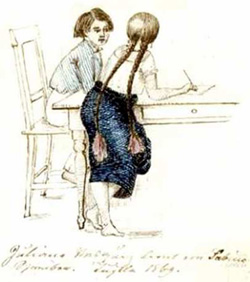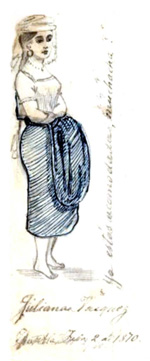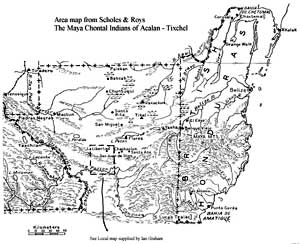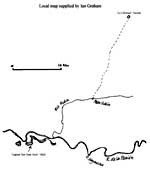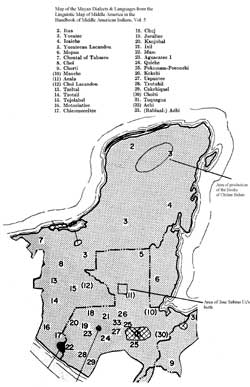
 |
THE FOUNDATION RESEARCH DEPARTMENT | ||||||||||||||||||||||||||||||||||||
An Autobiographical Note Written by José Sabino Uc in Yucatec Mayan in 1871 The accompanying transcript and translation is of an autobiographical note written in 1871 by José Sabino Uc, who was 14 at the time he wrote it. On the back of this note, in the hand of Karl Hermann Berendt, is written "Sabino’s Lebensgeschichte von ihm selbst erzählt in Maya Sprache, 1866". 1 Sabino’s note is amongst the Berendt papers at the University of Pennsylvania’s Museum Library. According to Brinton, 2 José was adopted by Berendt. Brinton met José while visiting Berendt during Berendt’s stay in New York during the years 1871-1872. His only mention of José is the following: "At that time he had with him a young Maya Indian, José Sabino Uc, whom he had adopted, and hoped to inspire with the love of study; but I have heard that the experiment turned out a failure, as is usually the case." Needless to say, José seems to have been taught to write Yucatec Mayan by Berendt and this autobiographical note is, as far as can be determined, the only surviving fruit of Berendt’s efforts with José. Click here to view photograph of José Sabino Uc. Aside from the above information by Brinton and that provided by the autobiographical note, nothing else has been found about José. A search through the Berendt material has yet to yield any more information, but this search has not yet been thorough. There are however a pair of exquisite line drawings in "Apuntes y Estudios sobre la lengua Zoque" done by Berendt at Tuxtla Gutierrez in 1869-1870 (Berendt Collection No. 111), the first of which shows a boy and the back of a girl with the caption "Juliana Vasquez lernt von Sabino" dated 1869, 3 and the second one of which is of a girl with the captions "Juliana Vasquez" and "Ya estás acomodada, muchacha?", 4 dated 1870. It should be mentioned that in April, 1866, Berendt was in Sacluk collecting linguistic data. It was in this town, now called La Libertad, that José’s father found a wet-nurse for José. There is a note in Berendt Collection No. 179 by Berendt on what he learned at Sacluk, but there is no mention of José Sabino Uc. Ian Graham has kindly sent me the accompanying map of the area talked about by José in his note. The route taken by José’s father from José’s birthplace on the lake of Akul, now called Laguna San Juan Acul, to the Pasion river, then up the Subim river and over-land to Sacluk can be followed. José’s autobiographical note, while very short, is interesting on two fronts: it provides us with a look at the Yucatecan Mayan language of the late 1800’s, and it gives us some ethnographical information. Ethnography In this note there is an interesting insight into how the kinship system using the word "Na" works. In colonial times this was a common naming device. Some other examples, which are in such material as the books of Chilam Balam, are the names such as "Na Puc Tun", "Na Pot Xiu", and "Na Hau Pech". Unfortunately it is not clear from this note whether the "Na" refers to "mother" or to "House" or something of that nature, nor are there any dictionary entries which shed light on this matter. In the beginning of the text José gives the names of both his parents. He gives his father’s name as being H-Na Menche Uc (line 8) and his mother’s name as being X-Na Kin Couoh (line 9) and his own name as being H-Na Couoh Uc (line 4). Thus apparently the mother’s last name is placed before the father’s last name to give the child’s name. The question is, does "Na" pertain only to the first word following it making the word "mother" or does it pertain to both words making the word "House"? The examples given do not clear up this point. It should be noted though that in this note and in the colonial literature in general the word "mother" is frequently spelled "naa", using the colonial convention of doubling the vowel to show a glottalized (clipped) vowel. The "na" of a name rarely appears as "naa". The implication of this is that the vowel is of normal length, and that the word therefore is derived from "house". 5 (Incidentally, of the four family names given by José, only the name Couoh is registered by Schumann as being presently used amongst the Itzas. 6 ) It is interesting that José knew the date of his birth. Even today there are many people in Yucatan who do not know their date of birth and can only guess at how old they are. Equally interesting is the fact that José’s father and older brothers were not baptized. Aside from the Lacandon, it would be rather uncommon for Mayans not to be baptized, at least at the present time. Pah keyem (sour corn gruel), which is carried about in a "pauo" (a shoulder bag woven out of fiber such as sisal) is still a common sustenance carried on long trips. Keyem becomes sour very quickly in the high heat and humidity in any case, with an orangish colored mold growing on it, but the Mayans have long since learned to live with this. Keyem, both fresh and sour, is a very important part of everyday life today, and is part of the "work tools" taken to the work place. Today, keyem, which is mixed with water and may be flavored by salt, chili, honey, or whatever might be at hand or brought along, is consumed in the late morning. Infants who lose their mother or whose mother loses her ability to give milk are taken in by someone else who is nursing. This is as true now as it seems to have been in José’s case. Frequently the child will stay with the nursing mother even after nursing has come to an end – especially if the nursing mother happens to be of the same family – and grow up in the adopting household. This is because the child’s feelings are generally respected. The child of course has become accustomed to its surroundings with the wet-nurse and feels that that is home. Usually the real parents ask at the end of the nursing period if the child wants to return to them, though I gather this is more a question of form and courtesy than of an expectation that the child would return to them, because, at least at the present time, there is little doubt in anybody’s mind that the child will probably want to stay with the wet-nurse. In José’s case we do not know what happened. Language It is interesting to note that the language of the autobiographical note is completely indistinguishable from Yucatecan Mayan with the exceptions noted below. It seems that José was born a Lacantun, as he calls his tribal group. It seems almost certain that "los Mayas de esta provincia del Peten" referred to by Berendt in his note on Sacluk were either Itza, Lacandon, or just possibly Mopan. The word "Lacandon" is a hispanification of "Lacantun". In the 1960’s it seems from Schumann’s work that Sacluk was within the sphere of Itza influence. 7 At the moment I do not have enough information to know what tribal group was in Sacluk in the 1860’s. Of course it could well be that José had made a switch to the Yucatec dialect some time before writing this autobiographical note, and so there is certainly no guarantee that we are looking at José’s original language. As noted, there are some exceptions to standard modern Yucatec in both grammatical and vocabulary usage in this autobiographical note. These exceptions are the following:
In fact, the autobiographical note as a whole has a very colonial feeling as far as the use of words and grammatical style is concerned. This similarity to older colonial Yucatec might be in part due to the frequently noted phenomenon of the language of a relatively small splinter group such as José’s tribal group changing less than that of the parent group. Of course it may well be that there were once several dialects in Yucatan and Peten as intimated in the "Linguistic Map of Middle America" in Handbook of Middle American Indians, Vol. 5. On this map one dialect is shown as being located along the northwest coast and is called "Itza" and a major dialect is shown to cover a good portion of the rest of the northern Yucatecan peninsula and is called "Yucatec". From the linguistic evidence that we have seen in José’s autobiographical note it seems that the tribal group that José grew up in belonged to the latter dialect. From various population reports on the peninsula of Yucatan it seems that the mortality rate amongst the western and particularly the northwestern Maya during the early colonial period was relatively low when compared to the mortality rate of the Maya living in the wetter eastern and southeastern areas where entire communities were wiped out in the years following the conquest by European-introduced diseases. Contrary to an opinion which I have held previously because of the relative uniformity of the present Yucatecan Mayan language throughout the Yucatecan peninsula, perhaps there were at one time different dialects in the Yucatecan peninsula, but because of the drastic toll European-introduced diseases took on the eastern and southeastern populations the dialect of northwestern Yucatan has been spread by emigrants from this area resulting in this apparent uniformity of the Mayan language in the Yucatecan peninsula today.
Here in the big town of Merida
Uay 9 ti noh cah ti Ho,
Sources Cited
Click to download the full report in PDF format: An Autobiographical Note Written by José Sabino Uc in Yucatec Mayan in 1871 (286 KB) The PDF files require Adobe Acrobat Reader.
David Bolles |
|||||||||||||||||||||||||||||||||||||
|
Text links to all pages at this site are available at the FAMSI INDEX |
|||||||||||||||||||||||||||||||||||||
